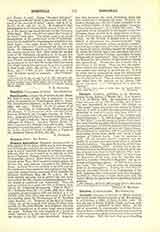

Donatello (DONATO DI NICOLO DI BETTO BARDI), one of the great Tuscan sculptors of the Renaissance, b. at Florence, c. 1386; d. there December 13, 1466. He was the son of Nicolo di Betto Bardi, and was early apprenticed to a goldsmith to learn design. At the age of seventeen he accompanied his friend Brunellesco to Rome, and the two youths devoted themselves to drawing and to making excavations in their pursuit of the antique. Half the week they spent chiselling for a livelihood. Brunellesco’s occupation was architecture; Donatello, though understanding the inter-relation of the two arts, always, whether in conjunction with Brunellesco or, as later, with Michelozzo, made sculpture paramount. It is hard to place his work chronologically. While still a mere boy, he carved the wooden crucifix in Santa Croce, Florence. On his return from Rome to Florence he was engaged for years on the statues for Giotto’s belfry and the buildings then in progress. For the Campanile he did “The Baptist”, “Jeremias”, “Habakkuk”, a group representing Abraham and Isaac, and the famous “David” called the “Zuccone” (Bald-head), so lifelike that Donatello is said to have himself cried to it, “Why don’t you speak?”; for the Duomo, “St. John the Evangelist” and “The Singing-gallery”; for Or San Michele, “St. Peter” and “St. Mark”, and the “St. George”, which he executed at the order of the Guild of Armourers—Donatello’s most ideal and perfect work. The socle-relief of “St. George and the Dragon and the King of Cappadocia’s Daughter” is absolutely Greek in simplicity and plastic beauty. Other fine reliefs are the bronze doors for the sacristy of San Lorenzo; the medallions for the ceiling; and the “Annunciation” in the same church, with its noble figures of the Blessed Virgin and the archangel. In the Loggia de’ Lanzi is the somewhat ill-proportioned roup of “Judith and Holofernes”. The marble “David” in the Bargello, uniting the delicacy of the adolescent “Baptist” of Casa Martelli with a classic fashion of wreath-bound hair, seems a link between two of the phases in Donatello’s development. Purely Renaissance and yet conceived in the antique spirit are the “Amorino” (Cupid) and the bronze “David” of the National Museum, Florence. Both are instinct with life and the potent vitality of youth, jubilant or contained. Pope John XXIII, a personal friend of the sculptor, died in Florence, 1419. Donatello made his tomb, a recumbent portrait-statue in the baptistery. In the Duomo of Siena he performed the same office for Bishop Pecci. In Siena also he made several rare statuettes and reliefs for the christening-font of San Giovanni. At Prato, for the open-air pulpit of the Duomo, he carved the casement with groups of playing children (putti). He is believed to have been in Rome again in 1433. A tabernacle of the Blessed Virgin in St. Peter’s is said to be by Donatello, and also the tombstone of Giovanni Crivelli in Santa Maria in Ara Coeli. In 1443 he went to Padua to build the choir-gallery, and remained there some ten years. First he carved his “Christ on the Cross”, the head a marvel of workmanship and expression; then statuettes of the Blessed Virgin, St. Francis of Assisi, St. Anthony, and other saints; also a long series of reliefs for the high altar. While in Padua Donatello was commissioned to make a monument to the Venetian Condottiere (General) Gattamelata (Erasmo de’ Narni), and he blocked out the first great equestrian statue since classic times. The last known statue of Donatello is “St. Louis of Toulouse” in the interior of Santa Croce.
Donatello became bedridden in his latter years, and some of his works were completed by his pupils. Piero de’ Medici provided for him. Donatello had always been lavish with his fellow-workers and assistants, and took no forethought for himself. His character was one of great openness and simplicity, and he had an ingenuous appreciation of his own value as an artist. Unassuming as he was, his pride of craft and independence of spirit would lead him to destroy a masterpiece at one blow if his modest price were haggled over. He was buried beside his patron Cosimo de’ Medici in the church of San Lorenzo in Florence. Donatello was a thorough realist and one of the first modelers with whom character and personality in the subject meant more than loveliness. His Apostles and saints were generally close likenesses of living persons. He had a vivid faculty for individual traits and expression and a method of powerful handling that makes it impossible to forget his creations. In such figures as the “Baptist” and the “Magdalen” of the baptistery of Florence he apparently studied emaciation for its anatomic value. His busts of contemporaries (such as that of Nicolo da Uzzano, “Youth with Breastplate”, etc.) look like casts from life. One of the most graceful pieces is the “San Giovannino”, a relief of a child, in sandstone, in the Bargello, Florence. Minor works are the “Marzocco” (original in the National Museum, Florence)—the lion, the emblem of Florence, with the fleur-de-lys florencee shield—and the Martelli escutcheon on the staircase of their house.
M. L. HANDLEY

